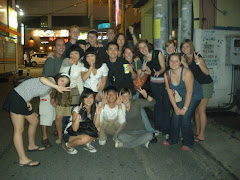For those who made it out to the social last night, I hope you all had a fabulous time! For those of you who couldn't make it, or who hadn't arrived yet, I will be organizing a similar social next weekend. The few with whom I've spoke this morning so far have said they had a great time. That was indeed the plan -- for you to have a great time TOGETHER your first weekend in Ulsan! (By the way, send some photos -- or tell me if you post any -- as we'd love to add them to our Ulsan album too!)
As for today:
If you want to see some of Ulsan's many cultural highlights (many of them very traditional, such as ruins and temples), then the TWO AREAS you want to explore are ULJU-GU and JUNG-GU. These areas are also right next to each other and almost overlap. Below are some the highlights. These areas have everything from dinosaur footprints and petroglyphs to one of the country's most modern sports complexes! If you decide you'd like to explore these areas today with some of the other teachers, the best area to meet would probably be Munsu Football Stadium. It is right in the middle of the two areas, and then you can decide where you'd like to go from there. Express you interest in meeting up on the Weekend Socializing Facebook group and hopefully you'll find others that are interested. (There's probably a main entrance where you could meet.)
Go to http://english.ulsan.go.kr/Tour/List.php?l=Tour&m=Mountain and click on "Tourist Guide Map." You'll be able to locate these two areas by looking for Munsu Stadium, then looking to the left (and mountain-ward) to fing Ulju-gu sites. Look to the right of the stadium, and still towards the top (most mountainous) part of the page that is least populated and you'll locate sites in the overlapping part of Ulju and then Jung-gu monuments slightly below them).
GOOD LUCK AND ENJOY THE REST OF YOUR FIRST WEEKEND!
HIGHLIGHTS IF ULJU-GU
STUPA OF CHEONGSONGSA SITE
689-861) San 107-4, Gaegok-ri, Cheongnyang-myeon, Ulju-Gun,
These three bell-shaped stupas, discovered in the Cheongsongsa site, were stone-towers to hold ashes of famous monks.
The left stupa(3 meters high) comprises Jidaeseok, Gidaeseok, a pedestal with a design of lotus petals and Tapsin(a main body).
(689-861) San 342, Gaegok-ri, Cheongnyang-myeon, Ulju-Gu,
It is located in Ul-ri, Cheongrang-myun, Ulju-gun, named after the Munsu mountain
Munsusa temple was built by Jijangulsa, priest in the period of Queen Seoduk of 27th
of Silla.
PETROGLYPHS
of Cheon-jeonri & Petroglyphs of Bangudae,
(689-841) San 207-8, Gumi-ri, Dudong-myeon, Ulju-Gun,
The designs of circles, mud snails, deer, fish, birds, snakes, human faces, etc. seen on the upper part of the rock, are interpreted as the symbols for the rite for abundance of that time, being used from the New Stone Age to the Bronze Age. The pictures of cavalry parade, sailing boats, dragons, horses, deer, and more than 300 characters on the lower part of the rock were left by people of the Three Kingdoms period and the Unified Silla, which indicates that people of Silla regarded this place holy since the Three Kingdoms Period.
SOMETHING IN THE
(this is sort of smack, right in the middle of Jung-gu and Ulju-gu. While it is technically in Nam-gu, it is the countryside/mountain-side area of Nam-gu which makes it close to Ulju-gu and Jung-gu.)
(680-843) San 5, Ok-dong, Nam-Gu, Ulsan
Acclaimed as the gem of the international football world, the Ulsan Munsu Football Stadium is the most frequented venue by Ulsan residents and tourists because of its spectacular scenery. Mts. Munsuand. Namam, and a nearby lake serve as natural backdrop.
THE AREA OF JUNG - GU
RELICS OF PARK JESANG
(689-842) San 30-2, Manhwa-ri, Dudong-myeon, Ulju-Gun, Ulsan
(this is really closer to the other sites in Jung-gu even though technically in Ulju-Gu)
Mangbuseok is a rock which involves a legend of a woman, missing her long awaited husband, who died and turned into a stone while waiting for him. There are other places with similar legends, but this is the best known.
Park Jesang was a famous loyal official during the reign of King Nulji(417~458) of Silla.
TOMBS OF DAUN-DONG
(681-340) San 147, Daun-dong, Jung-Gu,
This a large tumuli was built over the Unified Silla Period from the Bronze Age. Located at the foot of a hill between the Taehwagang(
FOSSILIZED DINOSAURS FOOTPRINT OF YUGOK-DONG
(681-310) 54-1, Yugok-dong, Jung-Gu, Ulsan
The footprints here, precious resources of natural history, are those of large and medium sized dinosaurs of the Lower Cretaceous period, about 100 million years ago.
BAEKYANGSA TEMPLE
819, Seongan-dong, Jung-Gu, Ulsan (681-300)
Baekyangsa temple is the oldest temple of those built in the period of Silla kingdom…It was built by Baeyangsansa, monk, in order to pray defense of the fatherland
ULSAN HYANGGYO
(681-240) 171-1, Gyo-dong, Jung-Gu, Ulsan
Hyanggyo (Confucian Academy) is a local public educational institution of the Joseon period. The structure includes a Confucian shrine and a school building. In the Confucian shrine, there are Daeseongjeon and Dongseomu. Daeseongjeon was dedicated to Confucius (552-479 B.C) and the Four Chinese Saints, the Two Chinese Sages, and the Eighteen Korean Sages.
NO-CAR STREET
[not really “traditional” but in the Jung-gu area, and worth checking out]
(681-210) Seongnam-dong, Jung-Gu, Ulsan
No-car Street was built in June 1998 in the area along the Hyundai Department Store, Seongnam Branch, which is the busiest street in Ulsan, to the four-way junction in front of the old Munhwatang. It was built as a cultural and shopping space that is 315 meters long and 10 meters wide. It was completed after three years.
** These highlights are excerpts from ulsan.go.kr **
